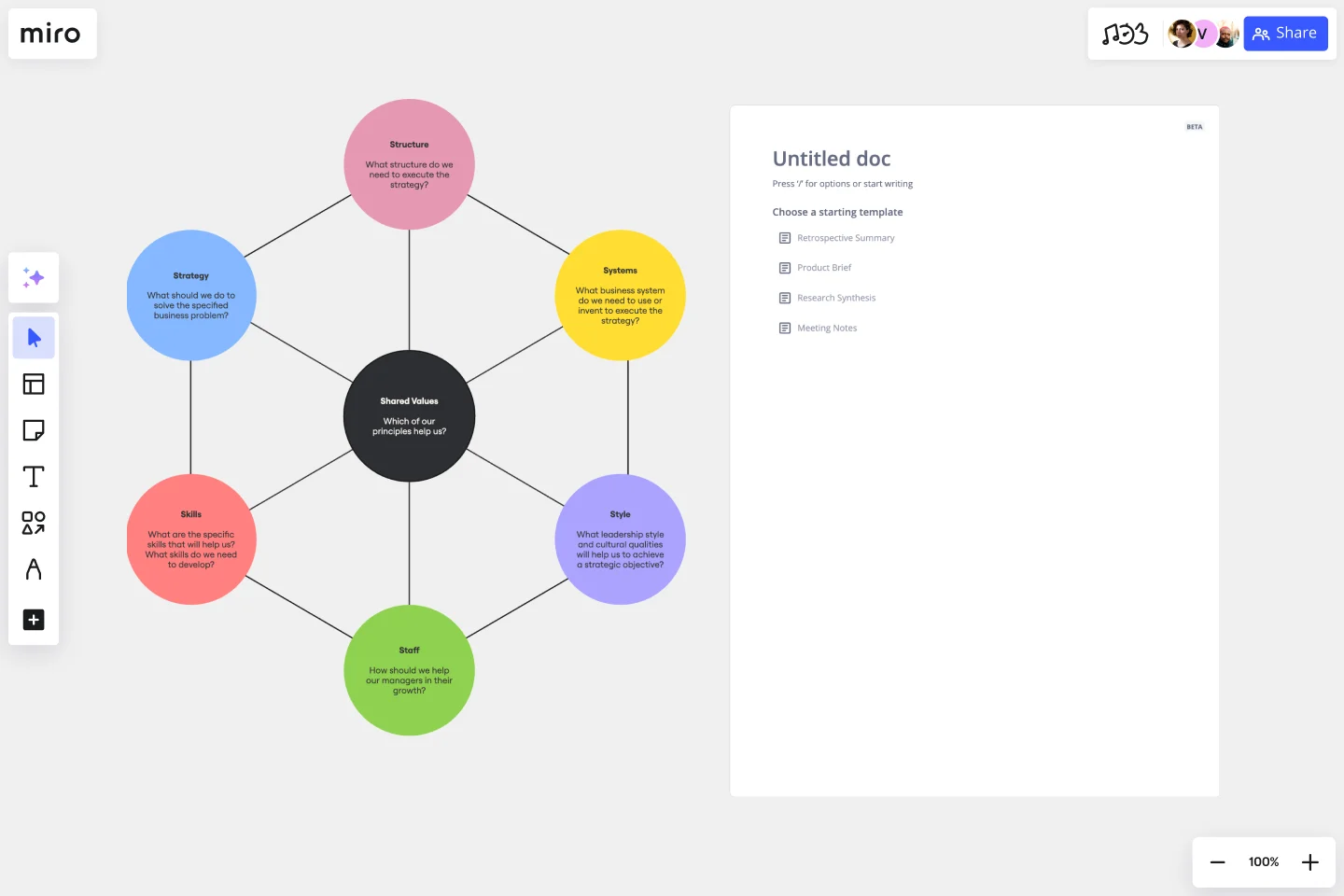7S Template
Discover how to holistically analyze and optimize your organization's interconnected elements with the 7S Framework Template. Ensure your business moves forward with clarity and cohesion.
About the 7S Framework Template
The 7S Framework Template is an insightful tool for organizations to understand the complex balance and interplay of different internal elements contributing to their success. With roots tracing back to studies conducted at McKinsey in the late 20th century, the 7S Framework focuses on seven elements: Strategy, Structure, Systems, Shared Values, Skills, Style, and Staff.
This template can evaluate and optimize operations by examining the seven interconnected elements. The 7S Framework template breaks down these elements into distinct sections, making it easier for teams to fill in, discuss, and analyze how each factor relates to the other.
How to use the 7S Framework template?
Using the 7S Framework template is a breeze. The template can be edited with just a few clicks to cater to your organization's unique needs.
Edit with ease: Once opened, each template section can be clicked to input or change information. You can adjust headings, content, and visual elements with simple clicks.
Expand as needed: Depending on your organization's depth and detail, expand the template dimensions to accommodate more data or combine it with other artifacts on your board.
Review and analyze: Once all sections are populated, review the template as a team. Discuss the interactions between the 'S' elements and identify areas of strength, opportunities, and areas that need alignment.
Save and revisit: After your session, save your modifications. Remember to review the framework periodically to ensure the ongoing relevance and alignment of all seven elements in your organization.
Why use a 7S Framework template?
Comprehensive analysis: The template offers a holistic view of your organization, highlighting hard (Strategy, Structure, Systems) and soft (Shared Values, Skills, Style, Staff) elements that drive performance.
Strategic alignment: By understanding how each 'S' relates to one another, teams can ensure that their strategies align with their capabilities and culture.
Facilitated discussion: The template acts as a conversation starter, making it more straightforward for teams to dive deep into discussions about areas of improvement and innovation.
Visualization: With a visual layout, it's easier to pinpoint areas of strength, gaps, and opportunities in the organizational structure.
Versatility: The framework isn't industry-specific, meaning organizations across various sectors can use it to refine their operations.
What do the "soft" and "hard" elements in the 7S Framework mean?
The "hard" elements (Strategy, Structure, Systems) are tangible. They can be quantified, whereas the "soft" elements (Shared Values, Skills, Style, Staff) are more intangible, often related to the organization's culture, values, and behaviors.
Can I customize the template for my specific industry needs?
The template is designed for adaptability, ensuring you can change it to fit the nuances and specifics of any industry or organizational structure.
How often should we revisit the 7S Framework?
While there's no one-size-fits-all answer, it's a good practice to revisit the 7S Framework periodically throughout the year, especially after major organizational changes, to ensure all elements remain aligned.
Is the 7S Framework only for large organizations?
Not at all. The 7S Framework is versatile and can benefit organizations of all sizes, from startups to multinational corporations, as it provides insights into optimizing internal operations.
Get started with this template right now.
Fishbone Diagram for Manufacturing
Works best for:
Fishbone diagram
In manufacturing, pinpointing the root causes of defects and inefficiencies is crucial. The Fishbone Diagram for Manufacturing template helps you systematically investigate issues related to production. Categorize potential causes into areas such as machinery, methods, materials, and manpower. This structured approach enables your team to collaboratively identify and address underlying problems, improving processes and enhancing manufacturing quality.
Product Development Gantt Chart
Works best for:
Gantt Chart, Planning
Developing a new product involves many steps and stakeholders. The Product Development Gantt Chart template helps you manage this complex process efficiently. Use it to outline each phase of development, set timelines, and assign responsibilities. Track progress and make adjustments as needed to stay on schedule. This template provides a clear visual representation, coordinating tasks for a successful product launch.
V2MOM Salesforce Template
Works best for:
Meetings, Strategic Planning
Align goals and strategies across your organization with the Salesforce V2MOM Template. Bring everyone together towards the same goals.
Timeline Meeting
Works best for:
Timeline, Planning
The Timeline Meeting template is tailored for planning and conducting meetings with a focus on time management. It helps you set clear agendas, allocate time for each topic, and keep track of discussion points. This template ensures your meetings are productive and stay on track.
5W1H Template
Works best for:
Strategy & Planning
The 5W1H Template is a strategic framework that clarifies complex situations or projects into six foundational questions: What, Who, Where, When, How, and Why. This methodological approach ensures a comprehensive understanding, encouraging teams to dissect and explore every aspect of a given challenge or project.
Goal Setting Template
Works best for:
Strategic Planning
The Goal Setting Template simplifies the process and fosters strategic thinking. It includes key fields such as goal articulation, rationale, action steps, and blockers. This promotes accountability with a "Date Started" field and a clear deadline. The template turns aspirations into actionable plans with a heightened sense of accountability.
